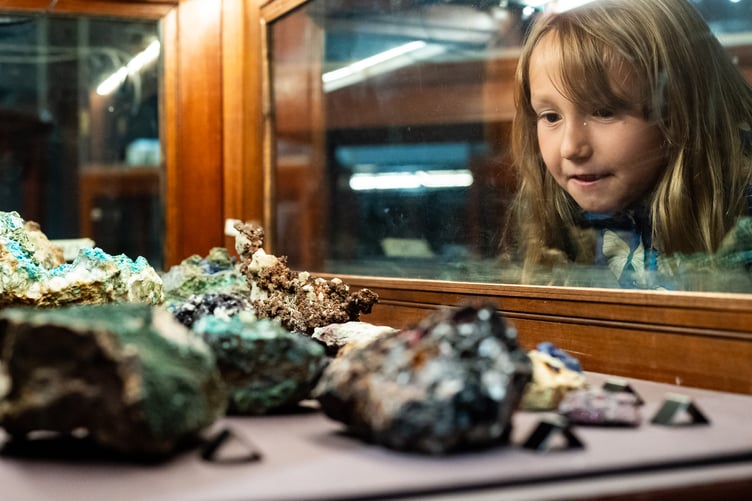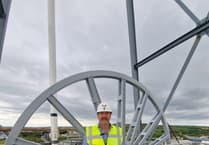FROM agriculture and construction to health and the technology we have come to rely on, minerals underpin our modern world and have an important story to tell.
They have played a crucial role in Cornwall’s past and are also playing a major part in its future, with lithium extraction enjoying a boom thanks to its use in batteries for everything from electric cars to smartphones.
Nowhere is this better illustrated than at the Royal Cornwall Museum, which launched its revamped mineral gallery to great fanfare on Thursday following a seven-month transformation. Glittering crystals are displayed from floor to ceiling; the walls take their dramatically dark colour from paint enriched with Cornish minerals; and the Edwardian displays have been rejuvenated and enhanced with audio recordings and interactive digital activities.
The invigorated space showcases some of the most spectacular specimens in a globally significant collection of more than 12,000 mineral samples, and takes visitors through a whistle-stop tour of 3,500 years of Cornish mining history, with exhibits including Bronze Age tools and Stannary Parliament stamps.
Dedicated to 18th-century collector Philip Rashleigh, the gallery was developed following consultation with museum visitors. The aim: to bring the story of the specimens to life, making geology engaging to an eclectic audience spanning local schoolchildren, scientists and academics.
An impressive wall-mounted cabinet designed to attract the eye pulls visitors in from the entrance hall, while the Edwardian cases were sympathetically renovated and adapted to be more accessible – some have been lowered to improve visibility for younger visitors.
Audio recordings - revealing the thoughts of former miners, the inspiration of local artists and music from the Cornish diaspora - can be accessed through speakers. A touchscreen enables users to deep-dive into the molecular structure of specific pieces, displayed on a gigantic screen that takes up an entire wall (and can be used for live events such as Zoom meetings and lectures).
Artwork from the museum’s extensive collection has been selected to compliment the displays. A portrait of a gentleman mine owner contrasts with that of Dicky Nine Lives, a miner who survived falling down Pednandrea Mine stack. See bal maidens tackling the back-breaking work of smashing up the mined rock, and marvel at industrial landscapes including South Crofty.
All corners of Cornwall are covered, from the China Clay of the Cornish Alps to the serpentine synonymous with The Lizard, via what was once the richest square mile in the world. While copper and tin dominate, several minerals in the 250-year-old Rashleigh Collection were the first of their kind to be formally identified - including kernowite, discovered in 2020 by mineralogists studying a rock taken from Wheal Gorland mine in St Day.
The process of updating the exhibition space involved careful dismantling, packing, labelling and storage of the minerals under the watchful eye of specialists from the National Museum Wales.
Artistic director Bryony Robins said: “This gallery holds a special place in many people’s hearts, not just because so many of the minerals are beautiful, but also because it’s an important collection for understanding Cornish minerals and the role that mining continues to play in Cornwall.
“Our goal is to ensure these improvements protect our collections and Institution, so future generations can continue to learn, explore, and visit us for another 200 years.”
Experts from the realms of conservation, industry and academia were called upon to shape the gallery, which is sponsored by Cornish Lithium.
“Minerals are the building blocks of the earth, and Cornwall’s unique geology and minerals have shaped the history of this region,” said Frances Wall, Professor of Applied Mineralogy at the Camborne School of Mines (part of the University of Exeter).
“We probably don't think about minerals very much and yet everything we do, every day, relies on them. Humans do two things - we grow plants and nurture animals. Every other material we use comes from the minerals in the earth. Phones, gadgets, high-tech renewable energy devices, cars, trains, machinery - all rely on minerals, so we should care about them very much.”
The work was made possible thanks to part-funding worth £476,000 from Truro’s Town Deal Board and Cornwall Council. This project is part of wider works to update the main gallery, nature gallery, entrance and garden, improving accessibility and responding to the brief of what a modern museum needs to be. This is due to be completed by March 2025, and is backed by £2.1m from the UK Shared Prosperity Fund.
The Royal Cornwall Museum celebrated its bicentenary in 2018, and visitor numbers have bounced back since the pandemic, reaching 41,000 in 2023.
Opening hours are Tuesday to Saturday, 10am to 4pm (also Mondays during school holidays). Entry costs £7.50 for an annual pass (under 18s free). Temporary exhibitions currently include a celebration of 200 years of the RNLI, and an exploration of Cornwall textile designers Crysede. royalcornwallmuseum.org.uk





Comments
This article has no comments yet. Be the first to leave a comment.